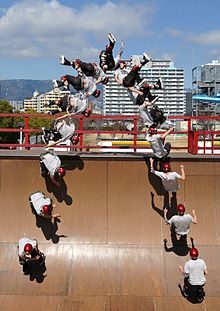
Vert skating or vertical skating is a discipline using skates like inline skates or roller skates on a vert ramp, a style of half-pipe. In vert skating, the skater is able to achieve more air-time as compared to other styles of skating, meaning skaters can perform complicated aerial maneuvers and acrobatic tricks, such as spins and flips.
The intent of vert skating is to ride higher than the coping (the metal pipe on top of the ramp) and perform spins or flips.[1] It focuses on complicated aerial maneuvers, such as spins and flips.[2] The intent of the skater is to build speed until they are of sufficient height above the edge of the ramp to perform various aerial acrobatics.[3] In competitions skaters have limited time, often less than a minute, to impress the judges by landing numerous and difficult tricks, having a good flow and consistency, having creativity with the routine and most importantly having a good style.[4]
The first X Games, in 1995, featured four inline skating events: best trick/big air, men's and women's vert, men's street, and men's downhill.[5] At its heyday in 1998, inline skating had the most events of any sport at the X Games, featuring vert triples (a three-person team based vert event), women's street, and women's downhill in addition to the original events.[6]
However, the sport soon fell out of fashion and by 2004, vert skating was the only remaining event at the X Games – including just one men's and women's combined contest.[7] For the 2005 X Games, aggressive inline was dropped entirely and the vert competition was replaced by women's skateboarding.[8]
Vert skating is considered a challenging sport: as of 2012 there are fewer than 15 professional vert skaters attending competitions.[citation needed]
- ^ "Vert Skating". Aggressive Skaters Association. Archived from the original on 26 October 2012. Retrieved 13 November 2012.
- ^ Williams, Carlesa. "What is vertical aggressive inline skating". liveabout.com. Retrieved 15 November 2012.
- ^ "Aggressive Skating". Inline Planet. Retrieved 13 November 2012.
- ^ "Yasutoko's new trick blows away competition". Kia X Games Asia. 1 May 2011. Archived from the original on 21 September 2011. Retrieved 13 November 2012.
- ^ Condor, Bob (20 June 1996). "Are these the next Olympians?". Chicago Tribune. Retrieved 14 December 2020.
- ^ "Summer X Games almanac (1995–1998)". ESPN. 15 August 2000. Retrieved 14 December 2020.
- ^ "The Death (and return?) of Aggressive Inline". Rad Rat Video. 25 August 2016. Retrieved 14 December 2020.
- ^ "Inline No Longer X Games Competition". ESPN. 8 March 2005. Retrieved 14 December 2020.